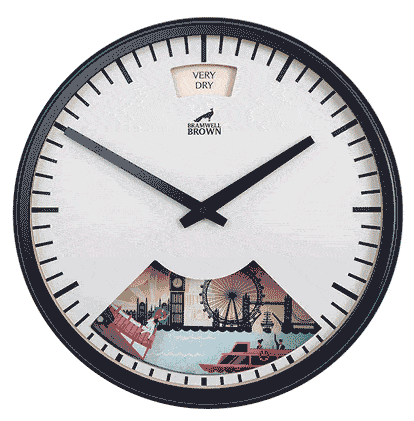The Bramwell Brown Blog
How to Muffle the Sound of a Ticking Wall Clock


The tick-tock of a wall clock can be a small, nostalgic comfort or become supremely annoying, especially when you're trying to focus or relax. There are a few ways that you can try to control the sound of your clock so that it is softer and less noisy. Some solutions may work better than others, so try a few to figure out what works best for your particular clock.
Insulating the Clock
Depending on the type of clock you have, insulating it may be a great option. This likely won't work well for pendulum clocks and might be okay for clocks that you don't need to see while you're muffling the sound.
You can insulate the clock with glass since it's a fairly effective acoustic barrier. Placing a glass case over the clock can help dull the ticking sound and still allow you to read the time visually. Laminated glass works best in this situation as it can dampen the noise more than tempered glass. A bonus of laminated versus tempered glass is that, should the case fall or slip, it will shatter in one piece rather than send pieces of broken glass over the floor. With that in mind, installing a case over the clock should be done with care.
Another way to insulate the clock is with acoustic dampening foam, like the kind that they use in recording studios. This option obviously removes your ability to read the time, so if you don't mind trading that for some quiet while you study or work, then this may be ideal to try. You can buy inexpensive sheets of foam and shape it into a case that can be placed over the clock. With this, you won't need to worry too much if it falls since it won't break or destroy anything else.
Quieting Internal Mechanisms
If you're able to open up your clock or the idea of glass or foam insulation isn't feasible, then working on the clock could be a fruitful solution. The gears inside may need some lubrication so that they can run more seamlessly. Use appropriate clock oil for the gears, since any substitute oil like WD-40 can actually ruin the gears. If you've got a clock manual, it may diagram the maintenance to go about keeping your clock in good working shape, not to mention keeping the gears running quietly.
Once oiled, let the clock sit for at least 15 minutes or more to make sure that it's running correctly. Add oil as needed, but be mindful that more isn't necessarily better. When you know that your clock is working fine you can then go in and add insulating foam around the internal mechanisms in order to dampen sound. This should be done with care since you don't want to affect how the gears move or have them blocked by the foam. This option may be particularly appealing if you're into DIY projects.
Stopping the Clock
Like using a foam case for your clock, simply stopping your clock may be a good temporary solution if you don't need to read the time, and it isn't terribly hard to reset the clock.
You may have to take out the battery in a wall clock or unplug it. Your particular clock may be finicky when it comes to resetting it, especially if the hands need to be moved manually and the gears don't respond well to it.
You'll also have to remember that it's been stopped since it's easy to glance at the time and not notice that the hands aren't moving forward in that quick instant that it takes you to read the clock. Creating a reminder to reset your clock, unmounting the clock and removing batteries may be more of a hassle than you are willing to go through every time you need some quiet.
However, if you're looking for something fast and simple that doesn't require buying or finding anything extra, this may be a quick solution for the moment.
Purchasing a New Clock
The reality is that some clocks will just make noise when they tick. The way the internal mechanisms and gears are put together means that when they move, they make a sound in order to push the hands forward. Some digital clocks may even make the same noise out of familiarity borne from original pendulum clocks that would tick when working. It's not necessarily a bad sound and can be a warm comfort at times.
If there's nothing tying you emotionally to the clock, it may be worth considering getting a new one. There are quite a few clocks on the market that are designed to run smoothly and quietly and could be a better investment than your current clock.
Bramwell Brown's clocks, for instance, display the weather with whimsical art and run noiselessly. They only slightly rumble and burble while little theatre of moving clouds starts to move as a result of atmospheric pressure change. It's worth mentioning that those moments are the most favourite moments for our customers because they know when the weather is changing.
If you're thinking of replacing your existing clock, this may be an excellent spot to start. If you don't necessarily need a clock that also shows weather, it still may be worth considering as the design of the clock doesn't interfere with being able to tell the time the way some other ostentatious timepieces may. They do also have a selection of Limited Edition clocks that feature different pictorials like a forest or bustling London town if traditional clouds and sun are not your style.
If you want to learn more about choosing the right clock, read our guide on how to choose a wall clock for your home.
If you're still hesitant on what to try, consider testing out a few of these methods first to see what works for you. Stopping the clock is a great temporary solution for the meantime while you either make a glass or foam case or work on getting oil and sound insulation. Getting a new clock is a matter of opinion and taste; it might be the simplest option in some cases, so it's worth some thought as well. It can also be a fun exploration to shop for a clock that updates and reflects your current style.
A fantastic addition to any room: take a look at our Weather Clocks






